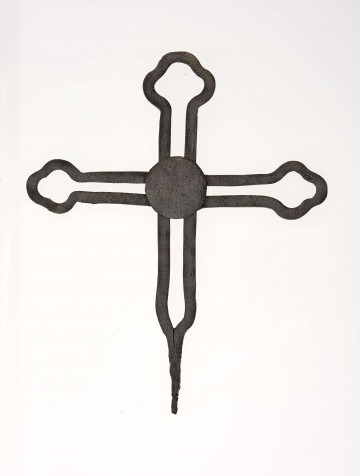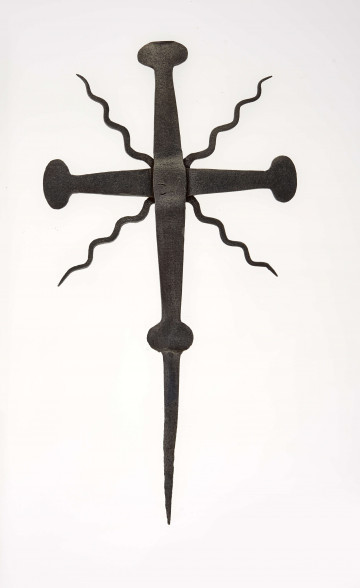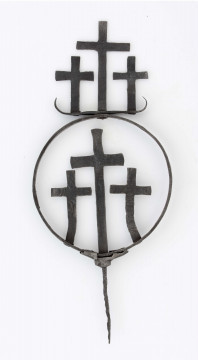
Cross
1901 — 1920
National Museum in Lublin
Part of the collection: Folk craft of the Lublin Region (19th/20th c.)
Wooden crosses in the form of Lorraine cross with two parallel arms, of which the upper one is shorter, were put up in order to magically protect against the plague and "moral air". Commonly called karawaka, they can still be found in several places in the Lublin region. They were placed at the edge of villages or at crossroads during the threat of an epidemic, with the intention of stopping the disease and protecting people. It was believed that the effectiveness was guaranteed by making the cross from one piece of wood overnight and setting it up at that time. The crossbars were sometimes engraved with words of prayers for the intercession of saints, and a third arm was added in the case of a longer supplication. However, not all crosses bore a prayerful request. A significant number of moral crosses in Poland had both crossbars of equal length. The custom of erecting them probably spread in the second half of the 17th century. In the 19th century, they were called cholera crosses, as epidemics of this disease decimated the population several times.
The cross came to Poland from Italy, after the Council of Trent, in the middle of the 16th century. The name is associated with the Spanish town of Caravaca de la Cruz, where there is a reliquary with splinters of the martyred cross of Christ in the shape of a patriarchal cross with two transverse arms. In its smaller form it became an amulet against many misfortunes and diseases, accidents or sudden deaths. It was supposed to protect against curses, theft, storms, lightning, floods and droughts. It cured severe, fatal diseases, but also helped with insomnia.
Karawakas were also erected to commemorate plague victims and to mark burial places. Apart from wooden ones, there were also metal ones, which were used as crosses on top of chapels or roadside crosses. The one in the museum's collection is such an example.
Author / creator
Dimensions
cały obiekt: height: 32 cm, width: 61 cm
Object type
cross
Technique
forging
Material
iron
Creation time / dating
Creation / finding place
Owner
The National Museum in Lublin
Identification number
Location / status

1901 — 1920
National Museum in Lublin

1890 — 1910
National Museum in Lublin

1863 — 1868
National Museum in Lublin
DISCOVER this TOPIC
National Museum in Szczecin
DISCOVER this PATH
Educational path